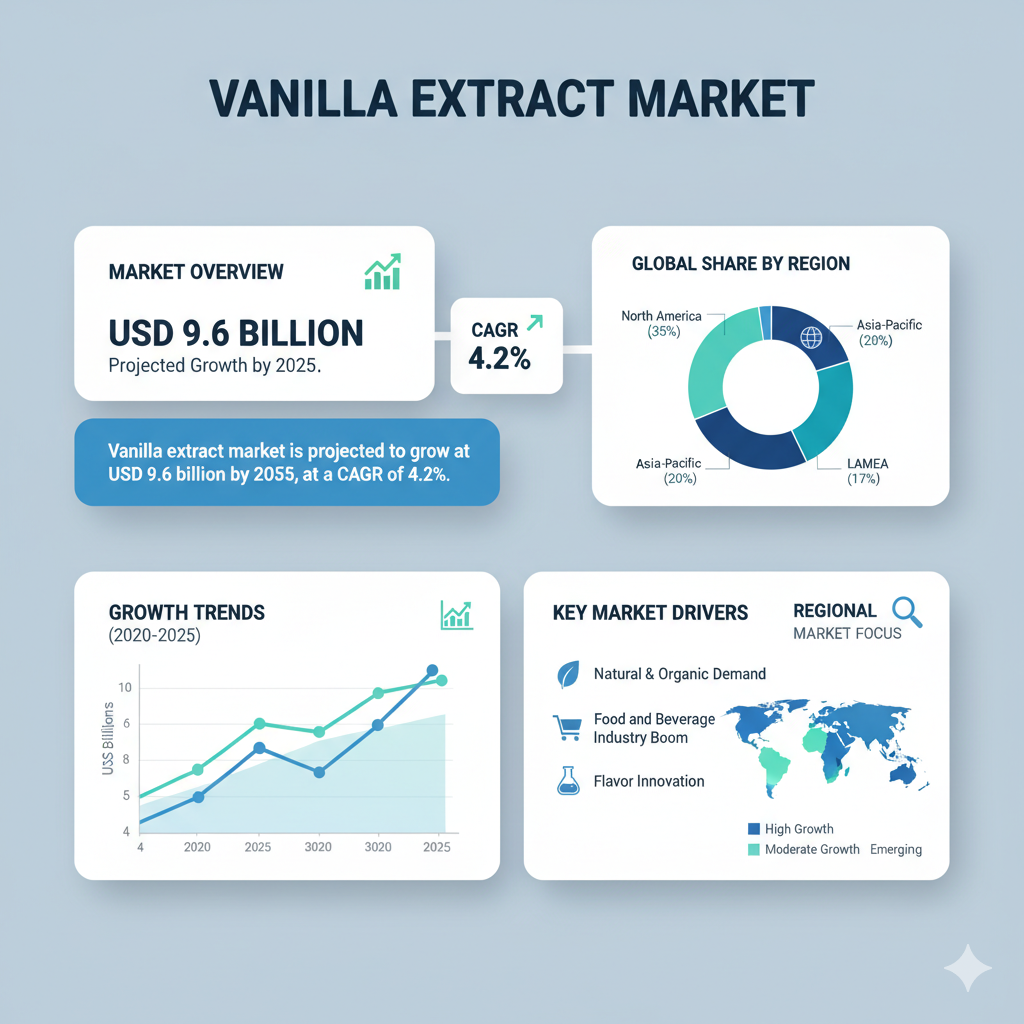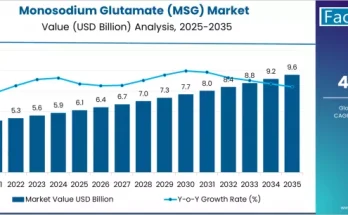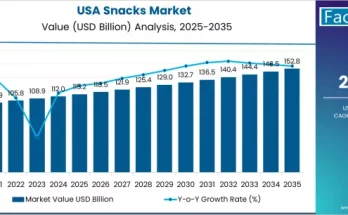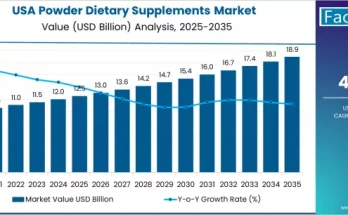The global vanilla extract market is valued at USD 6.3 billion in 2025. It is slated to reach USD 9.6 billion by 2035, recording an absolute increase of USD 3.3 billion over the forecast period. This translates into a total growth of 52.4%, with the market forecast to expand at a CAGR of 4.2% between 2025 and 2035.
Market Dynamics and Key Growth Drivers
The vanilla extract industry is experiencing strong growth, supported by a convergence of key market dynamics. Over the past few years, increased consumer interest in home baking and natural flavouring ingredients has boosted demand for authentic vanilla extracts. The preference for natural, clean-label ingredients has become a central driver of growth, as consumers are increasingly choosing genuine vanilla over synthetic alternatives.
Another major driver is the expansion of the bakery, confectionery, and beverage sectors, which rely heavily on flavour enhancers like vanilla extract. The bakery and confectionery segments are expected to hold nearly half of the market share by 2025. Additionally, the food and beverage industry’s increasing focus on premiumization and artisanal product development has elevated the use of high-quality vanilla extract in various recipes and products.
However, the market also faces notable challenges. Vanilla bean cultivation is highly sensitive to climatic conditions, leading to frequent fluctuations in raw material prices. The dominance of Madagascar as the primary source of vanilla beans adds a layer of vulnerability to the global supply chain. Furthermore, synthetic vanilla alternatives, which are cheaper and more stable in supply, continue to exert pricing pressure on natural extract producers. Despite these hurdles, the industry remains resilient, supported by ongoing efforts to strengthen supply chain transparency and sustainability.
Segmental Insights
The vanilla extract market can be segmented by type, application, distribution channel, and region. By type, natural vanilla extract remains dominant, accounting for the majority of market share. Its appeal lies in its authentic aroma and flavour, which synthetic variants struggle to replicate. In terms of application, bakery and confectionery continue to lead due to widespread usage in cakes, cookies, chocolates, and pastries. The food ingredient business-to-business (B2B) segment is also expanding rapidly, driven by large-scale demand from food manufacturing companies.
Regionally, North America and Asia-Pacific represent the most lucrative markets. The United States remains the global leader in consumption, driven by its mature food processing industry and the growing trend of clean-label ingredients. Meanwhile, Asia-Pacific countries are witnessing fast-paced growth, propelled by rising disposable incomes, expanding bakery culture, and an increasing number of food and beverage start-ups introducing locally inspired vanilla-flavoured products.
Recent Developments and Competitive Landscape
The competitive landscape of the vanilla extract market is characterized by a mix of established flavour houses, specialized vanilla producers, and diversified food ingredient companies. Leading players such as Nielsen-Massey Vanillas, Symrise AG, Givaudan SA, and International Flavours & Fragrances (IFF) dominate the market, while regional players and niche producers focus on organic and artisanal vanilla extracts.
Nielsen-Massey Vanillas continues to strengthen its position by emphasizing premium vanilla extracts and sustainable sourcing practices. Symrise AG and Givaudan SA, two of the world’s largest flavour and fragrance companies, have expanded their natural flavour portfolios to meet rising consumer demand for transparency and authenticity. McCormick & Company has also made strategic investments to enhance its product quality and supply chain resilience.
Recent developments in the market show a clear shift toward sustainability. Companies are investing heavily in fair-trade sourcing, farmer training programs, and environmentally responsible extraction methods. These initiatives not only ensure long-term supply stability but also appeal to ethically conscious consumers. Product innovation has also intensified, with new single-origin and organic vanilla extracts gaining traction among gourmet chefs, artisan bakeries, and premium dessert brands.
In addition, the geographic diversification of sourcing and production has become a key strategic move. To reduce dependency on Madagascar, several manufacturers are exploring new cultivation sites in regions like Indonesia, Uganda, and Papua New Guinea. This strategy enhances supply reliability while supporting the local economies of emerging vanilla-producing nations.
From a competitive standpoint, the vanilla extract market remains moderately concentrated. Large multinational players benefit from economies of scale, advanced extraction technologies, and extensive distribution networks. Meanwhile, smaller and regional companies compete by offering differentiated products such as organic, fair-trade, and single-origin vanilla extracts. Success in the coming decade will largely depend on the ability of these players to balance cost efficiency with quality and sustainability.
Outlook and Opportunity Landscape
With demand for natural flavours rising across global food and beverage markets, the outlook for vanilla extract remains highly positive. The ongoing premiumization of bakery and confectionery products, coupled with the expansion of the global café and dessert culture, presents immense opportunities for manufacturers. The shift toward clean-label and natural ingredients will further propel demand for authentic vanilla extracts, especially in the premium segment.
Beyond traditional applications, vanilla extract is finding new uses in ready-to-drink beverages, plant-based dairy alternatives, and health-oriented food products. The versatility of the ingredient ensures that it will remain a staple in both industrial and artisanal food production. Moreover, advancements in extraction technology and supply chain traceability will help stabilize prices and improve market confidence.
Emerging regions such as Asia-Pacific and Latin America are poised to become growth hotspots, supported by increasing urbanization, evolving consumer preferences, and a rising middle-class population. Companies investing in local production, tailored flavour profiles, and strategic partnerships are likely to gain a competitive edge in these markets.
Conclusion
The global vanilla extract market is entering a new era of growth, driven by evolving consumer tastes, the clean-label movement, and innovation across the food industry. While supply constraints and price volatility continue to challenge producers, sustainability initiatives and technological advancements are paving the way for a more stable and diversified market. Between 2025 and 2035, as the market expands from USD 6.3 billion to USD 9.6 billion, the companies that combine authenticity, transparency, and innovation will be best positioned to capture long-term value in this dynamic industry.



